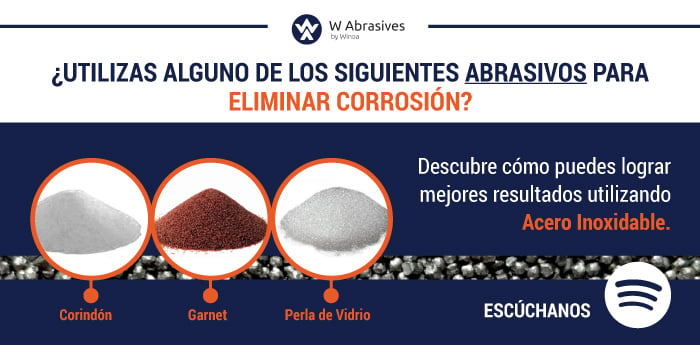
People use stainless steel for various reasons, including its mechanical properties and appearance. However, for most, the first thing that comes to mind is its resistance to corrosion, which makes it highly desirable for many applications. For example, stainless steel is used in the food, medical, construction, automotive, and marine industries, to name a few.
Stainless steel is often more expensive than carbon steel so choosing the right abrasive is essential. Doing so can significantly improve production efficiency, reduce rework costs, and reduce material waste.
Like carbon abrasives, stainless steel is also carbon-based, but with a significant amount of chromium (minimum 10.5%). Other elements such as nickel and molybdenum are added to improve its characteristics, mainly its resistance to corrosion.
Stainless steel products are generally used in applications that are exposed to very aggressive environments (saline, acid or alkaline environments). This corrosion resistance of stainless steel to aggressive environments is given by chromium, which reacts with oxygen to form a very thin layer of chromium oxide, this process also known as passivation.
Passivation is a process in which an inert, insoluble chromium oxide barrier is created that protects the substrate from the environment. Should this layer become mechanically damaged, the stainless steel will automatically restore the protective layer through this oxidation process, again creating the invisible layer.
Stainless steels are classified according to their microstructure and the amount of chromium, which defines their resistance to corrosion.
- We have the martensitic ones with 13% chrome, an example of these are the 400 series according to the American Iron and Steel Institute or AISI for its acronym in English.
- Ferritics with 18% chrome, also from the 400 series
- Austenitic with 18% chrome and 10% nickel, some contain up to 2% molybdenum, examples of these stainless steels. They are the AISI 200 and 300 series.
- And the ones with the greatest resistance to corrosion are the duplexes with up to 22% chrome and 5% nickel, examples of which are steel 2202, 2205
At W Abrasives we have two three types of stainless steel abrasives and in two shapes, round and angular.
Stelux C is our round-shaped stainless steel abrasive for cleaning applications such as aluminum parts for the automotive industry, castings, high-alloy steel ingots or bars, nickel super-alloy foundries, cobalt, parts structural aerospace industry. Surface preparation of wrought brass products for sanitary and domestic equipment, surface preparation for galvanized fences, on mechatronic components of magnesium alloys. Etc.
We have the Stelux CN also in a round shape, which contains nickel for better corrosion protection and is also used in cleaning applications of aluminum and magnesium castings for trucks, golf carts, lawn mowers, surface preparation. of heating systems such as radiators. Also non-ferrous castings for the automotive, energy and mechanical industries, as well as surface finishing of industrial fences.
And the Stelux CG which is an angular stainless steel abrasive with a much higher chrome content which is applied to materials such as stainless steel, nickel and titanium alloys, galvanized steel and non-ferrous metals. Its applications can be to prepare surfaces before coating or painting, cutting and surface preparation in wet environments, removal of calamine or remaining agents from heat treatments, surface finishing, etc.
The stelux stainless steel abrasive is an ecological product that is 100% recyclable and reduces the wear of the machine due to the lower generation of dust in the environment.
Many companies use carbon and stainless steel in their manufacturing operations. One of the biggest concerns is the possibility of cross contamination. Stainless steel can become contaminated in many ways, the most common being exposure to iron by using the wrong product. For example, cleaning or finishing with carbon steel abrasives on stainless steel can leave a residue due to the iron in the carbon steel, leading to a rust color (after rust) on the surface of those parts. When that happens, the stainless steel itself may not be rusty, but the part is still considered contaminated and the anti-corrosion properties will decrease.
Cross contamination can be avoided. Marking products to distinguish them can be valuable, as can dividing operations on the manufacturing floor between a carbon steel side and a stainless steel side. Limiting operator access to storage areas can also help. It is important to note that contaminated stainless steel may not always immediately show that it has been contaminated. Sometimes, it is not until the material is exposed to moisture that oxidation from surface contaminants begins to occur. This makes it even more critical to take extra steps to prevent costly cross-contamination in the first place.
At the end of the day, you need to find the right product for your applications. Using some of the tips here can help narrow down your options. Remember, when working with stainless steel, never cut corners when selecting or storing products for the job. Since stainless steel is expected to provide specific performance characteristics and is typically used in higher value parts, the wrong choice can damage the material and can end up costing you much more in the long run.
To find out what abrasives to use and what type of stainless steel suits you according to your type of application, do not hesitate to contact us for technical advice.






